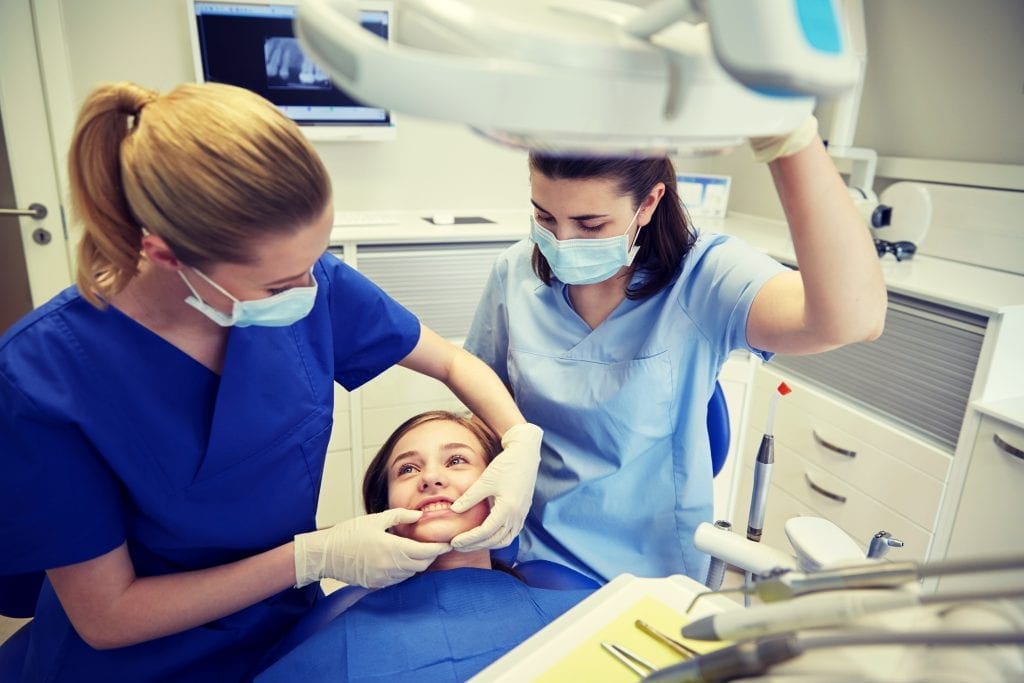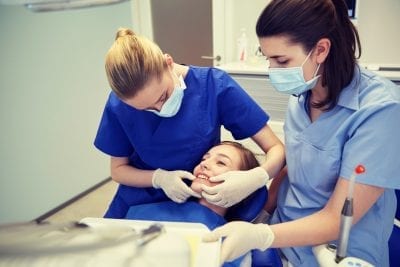Teeth occlusion refers to the way your teeth and jaw sit together or how your upper and lower rows of teeth contact with each other. To be more specific, it’s the relationship between your mandibular or lower teeth and maxillary or upper teeth when they come into contact with each other, like when you close your mouth or chew your food. The way your teeth are put together helps in the way you smile, speak, and eat.
You can have an underbite, overbite, or perfectly aligned teeth. Making sure you have the proper bite or occlusion is part of orthodontic therapy and can also be part of the job description of a dental orthodontist. Malocclusion, meanwhile, refers to the misalignment of the jaws and teeth, resulting in what’s known as a bad bite. Malocclusion can result in various dental complications (more on this below).
Problems with Malocclusion

Whenever there’s a misalignment with your occlusion, it can make your jaw muscles and face work harder, leading to bite problems and whatnot. If you have dental occlusion problems, this can result in the following complications:
- Teeth problems
- Sensitive teeth
- Wobbly teeth
- Fractured teeth
- Bodily problems
- Muscle tension
- Pain behind the eyes
- Neck aches
- Headaches
- Pain in the jaw joint
Types of Dental Occlusion
There are several types of dental occlusion.
- Static Occlusion: Static occlusion is the contact between your maxillary and mandibular teeth when the jaw is stationary and closed.
- Dynamic Occlusion: Dynamic occlusion is also known as articulation. There’s no tooth contact between the chewing side of the mouth’s teeth.
- Centric Occlusion: Centric occlusion is the opposing teeth occlusion when the mandible is centric. It’s the first tooth contact and may or may not correspond with maximum intercuspation.
This is also referred to as the ISP or intercuspation position, bite of convenience, or habitual bite. This shouldn’t be confused with centric relation, which is the relationship between the mandible and maxilla.
Extra-Oral Assessment
Before you’re fitted with orthodontics, splints, restorative crowns, or equilibration devices, the following must be done for the sake of extra-oral assessment or assessment of the shape of your face and jaw from the outside.
- Check for Skeletal Discrepancies and Facial Symmetry: The correctness or efficiency of your dental occlusion depends on how symmetrical or asymmetrical your face is and if your facial bone structure has any discrepancies or malformations that cause your malocclusion in the first place.
- Measure Lower Face Height: Your reduced face height might be caused by over-closure of your occlusion, resulting in occlusal stops and loss of teeth. In the absence of tooth wear, over-eruption might occur in patients because of a resulting dento-alveolar development and, in turn, an increase in face height.
- Temporomandibular Joints: The maximum extent that you can open your mouth is measured between the incisal edges of the lower and upper incisors. When doing an extra-oral assessment on you, the dentist should describe the deviation of mandible on opening or closing your jaw. Tenderness, crepitus, and clicking of the jaw should be taken note of as well.
Intra-Oral Assessment
It’s also important to assess that state of your bite or occlusion from the inside of your mouth through intra-oral assessment. This includes measurement and examination of the following points of observation.
- Intercuspal Position (ICP)/Centric Position: ICP is the centric position of the upper and lower jaws when there’s maximum intercuspation of the mandibular and maxillary teeth. ICP occlusion stability is important or else corrective dental work will be more complex to execute.
- Retruded Contact Position (RCP)/Terminal Hinge Axis Position: RCP is the comfortable back location of the mandible when it’s manipulated jointly or two-sidedly upwards and backwards in a retrusive (i.e., the backward displacement of teeth) fashion.
Its other name, terminal hinge axis, is all about the imaginary axis drawn through the head’s center with both condyles when the mandible closes and opens on the curvature arc. When the mandible closes on this axis, the first tooth contact is the RCP.
How Do You Treat Occlusion Problems?

A misaligned jaw or malocclusion can be the result of tooth grinding and excessive stress. If you’re suffering from constant neck ache or jaw pain, painful headaches, or tinnitus, you might be suffering from the effects of malocclusion of your jaw or jaw misalignment problems.
If that’s the case, then you should treat your occlusion issues with the following potential treatments designed to enable your mandibular teeth to come into contact with your maxillary teeth in an even fashion.
- Equilibration: This malocclusion treatment involves adjusting your teeth’s biting surface in order to improve its function. Dental or occlusal equilibration is a comparatively gentle procedure.It typically involves fixing one or more teeth in order to create a more solid bite that prevents teeth stress on each individual tooth. This treatment also reduces trauma or pressure on the jaw joints and muscles for good measure.
- Restorative Treatment: Your teeth can get dental crowns added to them in order to correct your bite and draw it into the right alignment. Instead of equilibration’s method of shaving or altering a couple of teeth in order to correct your bite, this is more about restoring bite.This therapy works either to restore the bite you’ve lost (due to bruxism, tooth decay, cavities, tooth loss or forced extraction, missing teeth, dental gaps, and so forth) or bring you a better bite by taking advantage of dental imperfections and making adjustments through them.
- Splints: Bite guards, dental splints, or occlusal splints are placed on the maxillary or mandibular teeth in order to alter the occlusion of the bite by virtue of jaw muscle relaxation. Splints are also helpful in terms of preventing fractures and teeth chipping.Splints aren’t only used to deal with dental occlusion treatment. It’s also the most common type of treatment for TMDs of temporomandibular disorders. These appliances include mouth guards and bite plates. They are also used for short periods. They don’t cause permanent changes on the jaw or teeth.
- Orthodontics: If you have an “incorrect” or inefficient bite that causes you more problems than benefits, then fitting in orthodontic braces should assist you in correcting your bite when push comes to shove.Fixed braces are usually the likeliest treatment of choice because they offer the maximum amount of movement. However, you can consult with your dentist and decide if this or another method is the best orthodontic method for you.Take note that the type of recommended occlusal adjustment service will depend on where exactly in your occlusion or bite the stresses or misalignment are as well as how damaged or worn your teeth are.
What to Expect of Malocclusion Treatment
Here’s what you should expect when getting treatment for a crooked bite.
- Minor Changes: Some patients only require the edges of their teeth altered to provide a better fit for a decent bite, which is also known as equilibration. This is suitable for minor cases wherein just a few teeth are causing your malocclusion issues. This is minimally invasive and changes only a few things through mostly minor dental work.
- Dental Damage: If you’re dealing with a more acute issue, then your dental professional can take measures to offer you quality bite restoration. This work will rely on the current condition of your teeth, so the dentist should approach it on a case-by-case basis. Implants, bridges, and crowns are often used to repair dental damage.
- The Bite Structure Itself: If it’s the bite structure itself that’s poor, then the patient might need orthodontics or braces instead. This is a long-term kind of treatment that typically utilizes braces that move your teeth into the correct position over time. Over recent years, there are orthodontic treatments that are more aesthetically pleasing and less intrusive when it comes to your quality of life.
- Adjusting an Existing Dental Treatment: When installing a new crown, partial dentuce, bridge, or dental implant restoration, the opposite of a good bite might be induced, necessitating further adjustments from either the restorations themselves or the neighboring teeth. The changes can even include tooth mobility, a wider periodontal ligament space, and pain. Thankfully, this type of occlusal trauma is fixable and reversible.
The Value of Occlusal Adjustment
Most dental patients resist treatment if they’re not in pain or lack crooked, yellowed teeth. However, there’s more to dentistry than fixing dental cavities, dental hygiene, and cosmetic treatments. Orthodontic treatment recommendations might be called for to fix poor aesthetics and an inefficient bite that might spell trouble for them in the future.
- Initial Patient Resistance: Patients tend to be impatient and resistant regarding orthodontic or occlusal adjustment treatment recommendations. Getting braces to improve one’s bite is viewed as expensive and troublesome to deal with by adults with malocclusion that lacks pain.
The usual reasons for this is because of the poor aesthetics of braces, the duration of the treatment, the difficulty of wearing appliances, and the cost of such treatments in the first place. If the patient isn’t in pain then they’re not as receptive to treatment.
- Emphasizing the Negative Consequences of Malocclusion: Patients are more willing to get orthodontic help or some type of other occlusal adjustment treatment if they’re aware of the negative social, psychological, and physical impacts of having a bad bite (like fractured teeth and bruxism).
You or a loved one should research on how malocclusion can cause tooth wear-down, jaw alteration, and dental crookedness. Alas, malocclusion seldom causes pain until it’s already reached an advanced level like TMJ pain, periodontal complications, gum recession, and primary occlusal trauma.
- Key Motivators of Orthodontic Treatment: According to a report by the American Association of Orthodontics back in 2011, the desire of patients to correct malocclusion roots from wanting to straighten their teeth and improve their smile. These are their key motivations for seeking orthodontic treatment.
Other motives include closing dental spacing or gaps, improving facial appearance, and bettering the bite. Considering the psychological factors of facial aesthetics, body image, and self-image, the orthodontic group in the study was comparable to the public at large.
More Than Just Straightening Teeth
Most laymen believe that all they need is to get straight teeth in order to get the perfect smile and dental work done. However, it’s more like they need to look for a good bite instead. Cosmetically improving the evenness of their pearly whites and bleaching them for good measure can only go so far if they have misaligned teeth or malocclusion. Your teeth should look great and have proper contact from the rows of teeth above and below.
Orthodontics is quite the exciting field in and of itself. It’s no longer a field reserved for children who wish to have their teeth straightened throughout their childhood or formative years. There are also adults who depend on this discipline in order to improve their bite and how their upper and lower rows of teeth get into contact with one another.
Dentists may alert their patients if they have occlusal or periodontal problems, necessitating assessments and treatments. Based on the resulting recommendations and examinations, people with malocclusion might undergo occlusal therapy like orthodontic treatment a la Invisalign or ordinary braces, occlusal adjustment, splinting, or wearing a night guard.
It’s not enough to get a cosmetically appealing smile. Patients must also demand occlusal health and the correct bite.
Conclusion Regarding Malocclusion

Protective management is called for when it comes to patients affected by tooth surface loss. This is all about the elimination of the primary cause of loss with careful selection and use of restorative techniques to preserve or improve upon your occlusal stability. If your teeth are suffering from wear-and-tear, then an occlusal splint can mitigate further damage where loads on your teeth are at a high level.
If preventive strategies to avoid malocclusion complications are not complied with or haven’t even been introduced in the first place, then the dentition might end up worn down to the point of dentists having trouble providing fixed restorations. As a consequence, removable dental prosthetics are usually utilized for the sake of restoration of bites affected by tooth surface loss.
Thantakit International Dental Center is Thailand’s longest established dental center. Situated in Bangkok, our clinic is renowned across the world as a destination for world-class dentistry, with most of our patients flying to us from Australia.
Please contact us today and get a FREE dental consultation.












